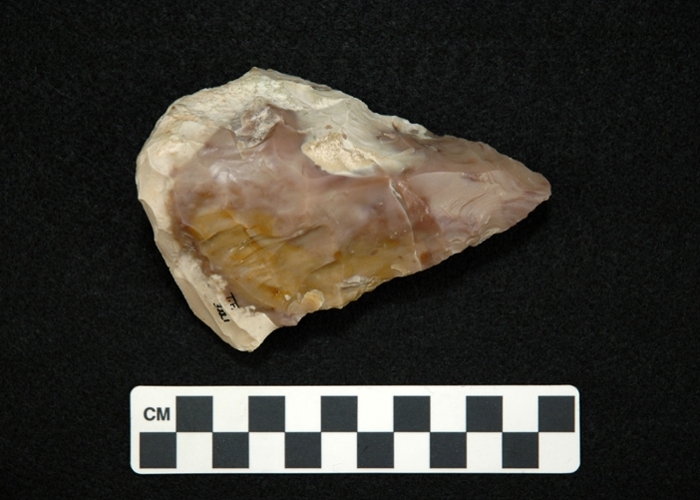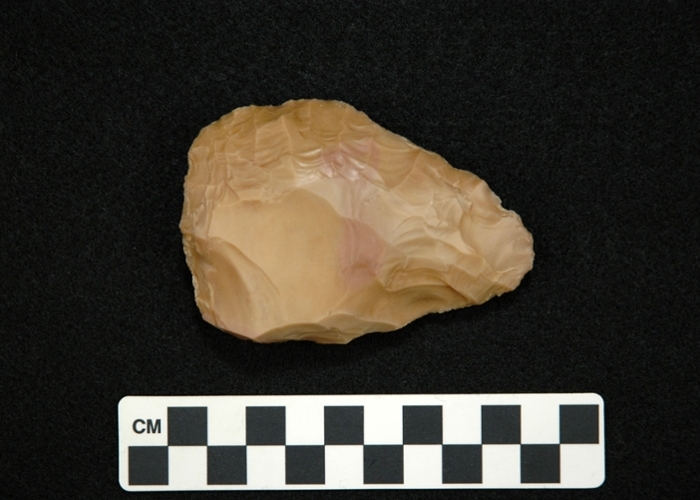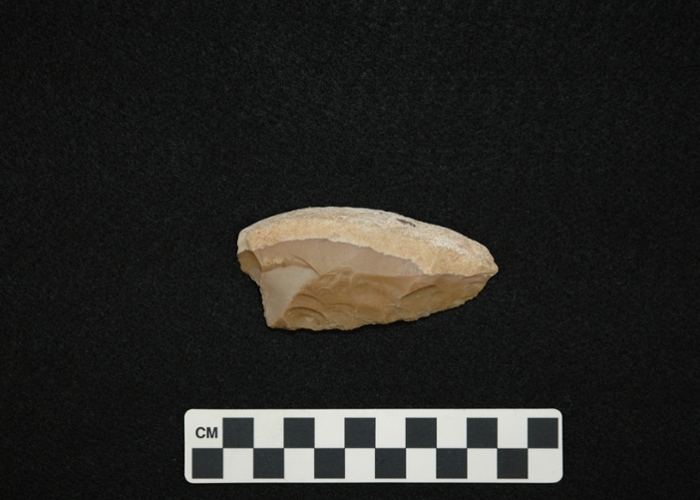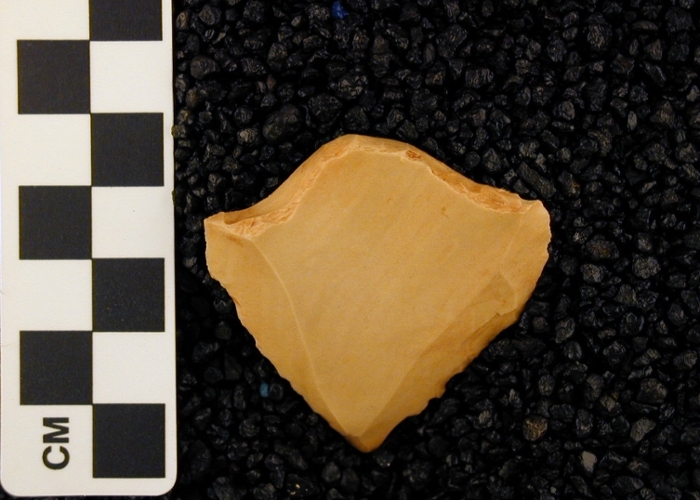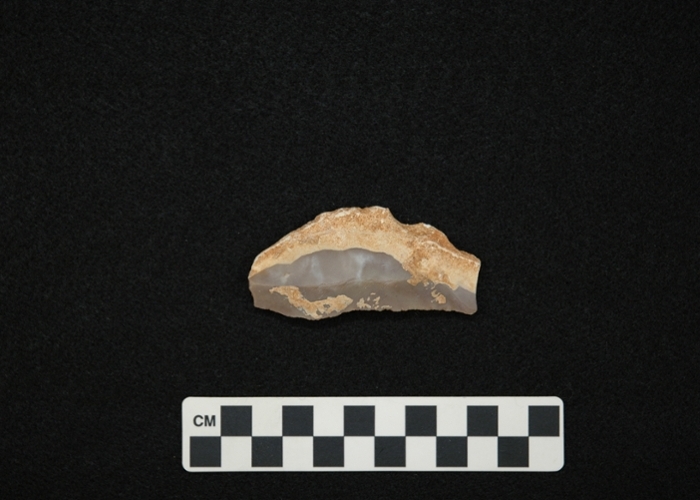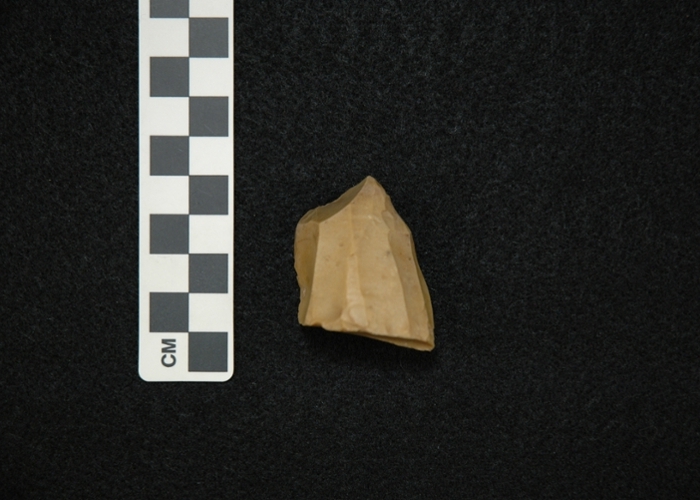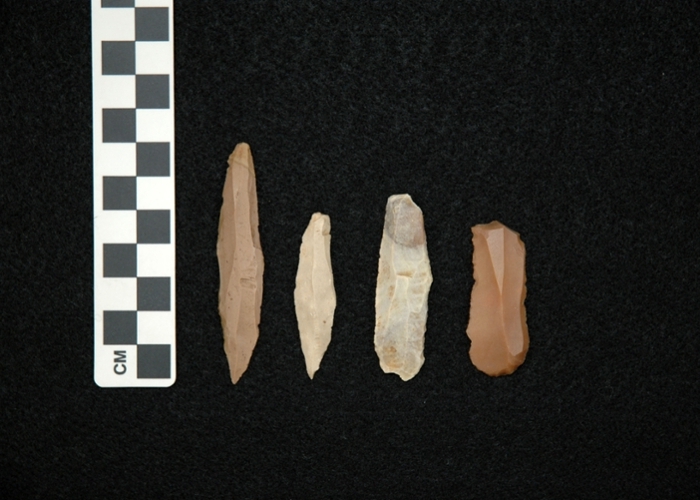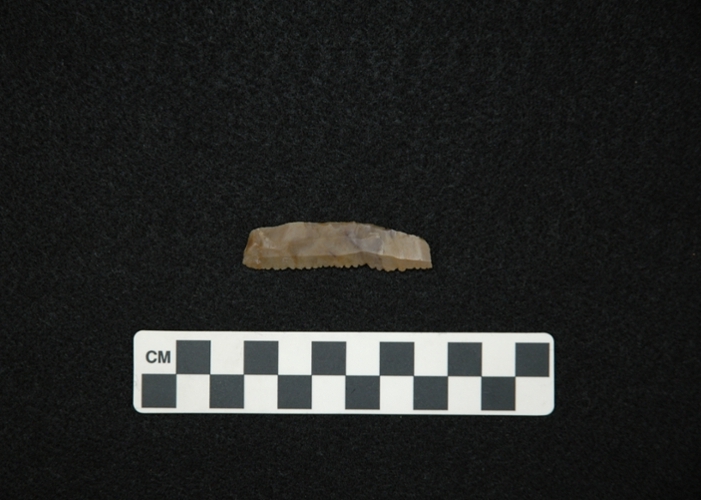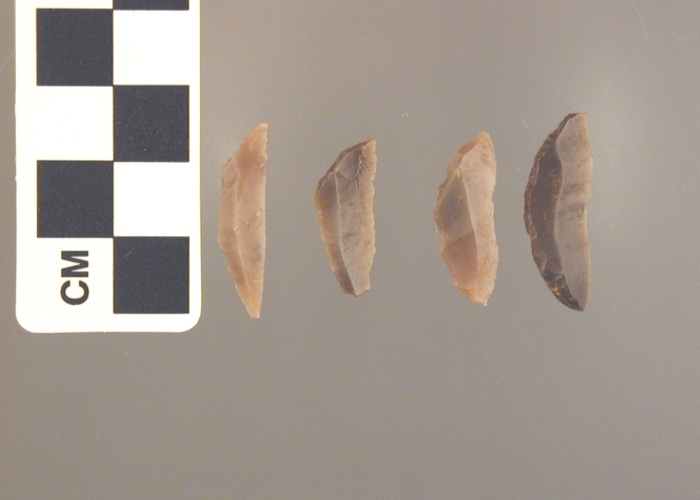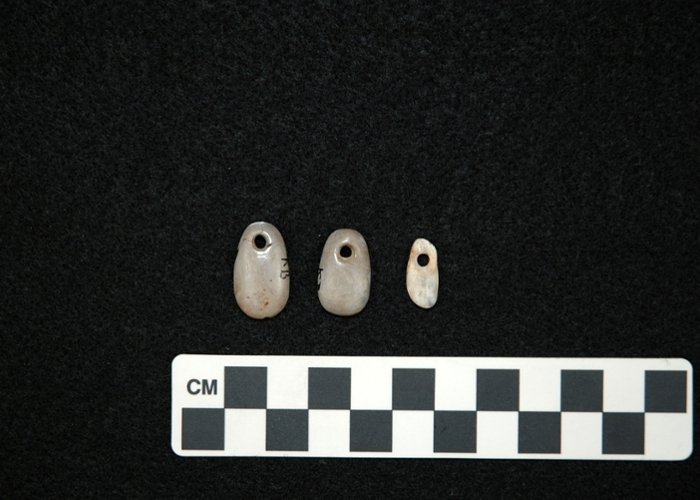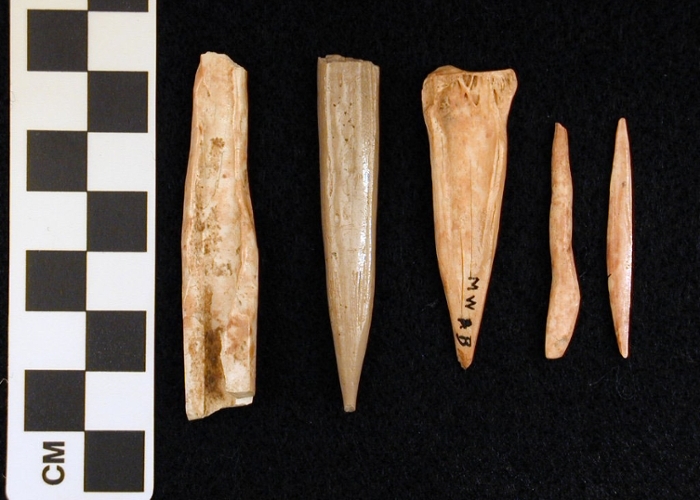Paleolithic Tools from Mount Carmel
-
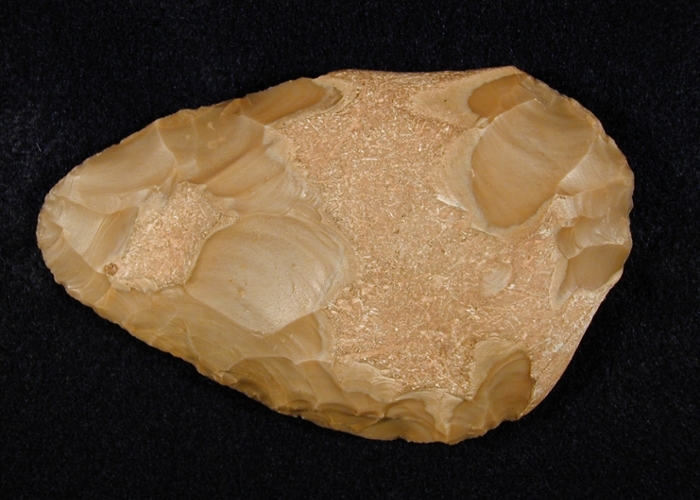
Acheulean Handaxe
Accession lot 3220
Mugharet et-Tabun (Cave of the Oven)
Upper Acheulean layer
ca. 300,000 - ca. 400,000 years ago
13.5 cm long x 8.4 cm greatest widthThe term "Acheulean" derives from the site of Saint-Acheul in northern France, but refers to a recognizable type of stone tool technology that is found throughout Africa, Eurasia and Europe. Also known as "Mode 2" technology, Acheulean assemblages are characterized by such large bifacial (flaked on both sides) handaxes. This handaxe retains some of the original cortex, or outer covering of the flint cobble. This may have been left in place intentionally to serve as a handhold.
-
Acheulean Handaxe
Accession lot 3221
Mugharet et-Tabun (Cave of the Oven)
Upper Acheulean layer
ca. 300,000 - ca. 400,000 years ago
13.5 cm long x 8.4 cm greatest widthThe term "Acheulean" derives from the site of Saint-Acheul in northern France, but refers to a recognizable type of stone tool technology that is found throughout Africa, Eurasia and Europe. Also known as "Mode 2" technology, Acheulean assemblages are characterized by such large bifacial (flaked on both sides) handaxes. This handaxe retains some of the original cortex, or outer covering of the flint cobble. This may have been left in place intentionally to serve as a handhold.
-
Acheulean Handaxe
Accession lot 3221
Mugharet et-Tabun (Cave of the Oven)
Upper Acheulean layer
ca. 300,000 - ca. 400,000 years agoThis specimen clearly exhibits scars of both the broad primary flakes (in center of image) that provided the rough form of the tool, as well as the smaller secondary, or finishing, flakes used to refine the tool's shape and give it a sharper edge.
Compared to Mode 1 technology, characterized by minimally modified cobbles and rock fragments, Mode 2 represented a real innovation. This technology not only produced a versatile tool with a greater amount of useable working edge, but also required the maker to have the cognitive ability to look at a lump of raw material and conceptualize the desired final form, as well as the technical ability to execute its production.
-
Convergent Scraper
Accession lot 3223
Mugharet et-Tabun (Cave of the Oven)
Upper Acheulo-Mousterian layer
ca. 200,000 - ca. 275,000 years agoThe term "Mousterian" also derives from a specific site in France, but is used to refer to a recognizable stone tool technology found throughout portions of Europe, North Africa and the Near East. This technology is typically associated with Neanderthals, but it was also produced by anatomically modern humans. It is also known as "Mode 3" technology, and is characterized by an emphasis on tools made from stone flakes, like this scraper, that were struck from pre-shaped cores.
-
Mousterian Point
Accession lot 3221 or 3222
Mugharet et-Tabun (Cave of the Oven)
Lower Mousterian layer
ca. 120,000 - ca. 200,000 years agoThis point shows clear evidence of having been produced via the prepared-core Levallois technique, as evidenced by the remains of previous flake scars on the striking platform (the little "bite marks" visible at top of image). This technique involved careful initial shaping of a stone cobble so that a large flake could be removed, pre-shaped into a specific tool form.
-
Backed Knife
Accession lot 3226
Mugharet es-Skhul (Cave of the Kids)
Lower Mousterian layer
ca. 100,000 - ca. 130,000 years agoThis sharp flake knife was cleverly struck so that a layer of the original cortex serves as a natural "back," or blunted edge that could be held by the user. Archaeologists have done experiments with replicas of such knives to prove that they could be used to efficiently skin and butcher large animals.
-
Blade Core
Accession lot 3227
Mugharet el-Wad (Cave of the Valley)
Upper Paleolithic layers
ca. 30,000 - ca. 40,000 years agoUpper Paleolithic stone tool technology is characterized by a variety of implements made from blades (a specialized type of flake) produced from prepared cores like the one pictured here. Such "Mode 4" technology is part of the so-called "Great Leap Forward," which is when we first see prolific evidence of anatomically modern humans engaging in complex social behavior, including symbolic representation like the creation of cave paintings and carved figurines.
-
Blade Tools
Accession lot 3186
Mugharet el-Kebara (Kebara Cave)
Upper Paleolithic layers
ca. 32,000 - ca. 40,000 years agoBlades are defined as flakes that are at least twice as long as they are wide. They may be used, unmodified, as cutting or piercing tools. They can also be modified, via additional shaping, into tools used for scraping, grinding, notching, drilling and etching a variety of materials.
-
Serrated Blade
Accession lot 3186
Mugharet el-Kebara (Kebara Cave)
Natufian layer
ca. 11,500 - ca. 14,500 years agoDoes this tool look familiar? Serrated blades have been a part of the human toolkit for over 12,000 years. The same technology that is now used to cut steaks and saw through bone and wood was probably originally used for processing fibrous plant stalks.
-
Microliths
Accession lot 3185
Mugharet el-Wad (Cave of the Valley)
Natufian layers
ca. 11,500 - ca. 14,500 years agoSmall, razor-sharp tools like these could have been used individually as arrow tips or hafted on handles in groups to form spears, harpoons or saws.
-
Bone Beads
Accession lot 3186
Mugharet el-Kebara (Kebara Cave)
Natufian layer
ca. 11,500 - ca. 14,500 years agoThese beads may look like they are carved from stone, but they are actually made from calcined (or burned) animal bone. Burning the bone reduces it largely to its mineral components, hence the bluish-grey to white color. Beads like this were used in personal adornments found buried with the people Garrod termed "Natufian." Natufian peoples were anatomically modern hunter-gatherers whose exploitation of wild cereals and other plant resources allowed them to be semi-sedentary before the development of formal agriculture.
-
Bone Tools
Accession lots 3185 and 3186
Mugharet el-Kebara (Kebara Cave) and Mugharet el-Wad (Cave of the Valley)
Natufian layers
ca. 11,500 - ca. 14,500 years agoFrom the Upper Paleolithic on, there is ample evidence that early humans used materials other than stone - such as bone, antler, and ivory - as part of their toolkit. The long bones (limb bones) of animals could be split and shaped into tools like awls, picks and needles.
